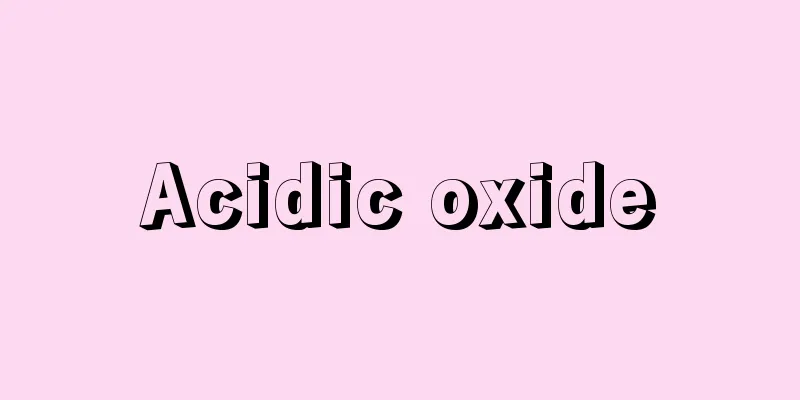Acidic oxide

|
Acidic oxides can react chemically with alkali to produce salt and water. Generally speaking, most non-metallic oxides are acidic oxides. Acidic oxides belong to acid anhydrides. The more common ones are sulfur dioxide, called sulfuric anhydride, and carbon dioxide, called carbonic anhydride. Their common feature is that they can react chemically with water to produce acids, and react with alkalis to produce salt and water.
Generally, they are non-metal oxides and high-valent oxides of certain transition metal elements. For example, phosphorus pentoxide P2O5 [that is, the anhydride of phosphoric acid], manganese heptoxide Mn2O7 [that is, the anhydride of permanganic acid], chromium trioxide CrO3 [that is, the anhydride of chromic acid], etc. CO, NO, etc. are neither acidic oxides nor alkaline oxides, but non-salt-forming oxides. Water is a special oxide. We know that alkali reacts with acid to produce salt and water, alkali reacts with certain non-metallic oxides, and carbonate reacts with acid to produce salt and water. For example 2NaOH+CO2=Na2CO3+H2O Ca(OH)2+SO3=CaSO4+H2O Ca(OH)2+SO2=CaSO3↓+H2O Such non-metallic oxides are called acidic oxides Most non-metallic oxides are acidic oxides. Among the non-metallic oxides we are familiar with, carbon monoxide and nitric oxide are not acidic oxides. Because their properties are different from those of acidic oxides, they are usually not classified as acidic oxides. NO2, N2O, etc. are not acidic oxides either. Generality 1. Reacts with water to generate the corresponding acid (except for silicon dioxide SiO2, which does not react with water) 2. Reacts with alkali to produce only one salt and water 3. Reaction with alkaline oxides
1. Most acidic oxides can directly combine with water to form oxygen-containing acids. CO2+H2O=(reversible)H2CO3 SO3+H2O=H2SO4 SO2+H2O=(reversible)H2SO3 (sulfurous acid) 2. Oxygen-containing acids can also be decomposed by heat to produce acidic oxides. For example, heating sulfurous acid can produce sulfur dioxide and water: H2SO3=SO2+H2O Here, sulfur dioxide can be regarded as the product of dehydration of sulfurous acid. SiO2, N2O5, are also acidic oxides, but silicon dioxide is insoluble in water and cannot directly react with water to form silicic acid. 3. The most important basis for determining acidic oxides is that the valence of each element remains unchanged before and after the chemical reaction. 4. It is composed of two elements, one of which is oxygen.
Most of the acidic oxides are non-metallic oxides. Most of the non-metal oxides are acidic oxides. Only oxygen-containing acids have acidic oxides. Carbon monoxide, nitric oxide, and nitrogen dioxide are not acidic oxides. |
<<: How to get rid of fleas on your body
>>: There are small red bumps on the tongue
Recommend
Causes of teratoma
Teratoma is a common germ cell tumor that origina...
What can I eat to grow taller?
Dietary therapy can effectively help some of our ...
What are the symptoms of chronic liver cancer? Revealing the three major symptoms of chronic liver cancer
Chronic liver cancer is a frightening disease bec...
How to treat a white tongue and bad breath?
In life, many people have oral problems, among wh...
Is there any medicine for dizziness caused by late stage brain cancer?
At present in our country, due to the continuous ...
Can yew be placed in the bedroom?
Yew is a very good plant. Many people will buy ye...
How long can I live if esophageal cancer recurs
Esophageal cancer is a common malignant tumor of ...
Development time of secondary sexual characteristics
Puberty is our second development period. Girls d...
How to use your hips to do squats
Squats are a very common exercise method. Nowaday...
Can toner be put in the refrigerator?
Some girls are afraid that their skin care produc...
Will you definitely die if you have melanoma?
Is melanoma a deadly disease? Most people probabl...
What harm does rectal cancer bring
What harm does rectal cancer bring? Rectal cancer...
What's wrong with my left arm twitching
If you often feel twitching in your arms, you may...
Analysis of pathological changes in melanoma
Melanoma lesions often occur at the junction of t...
Briefly describe the Western medicine treatment methods for pancreatic cancer
Western medicine treatment of pancreatic cancer c...









